17 Types Of WHITE BIRDS In Florida (ID Guide With Photos)
Did you recently see a white-colored bird in Florida? In that case you’ll probably want to know what species you saw.
Identifying white-colored birds in Florida is not as easy as you might think, since there are 17 different types of white bird species in the state.
To help you identify the bird you saw, we’ll cover all the types of white birds that can be seen in Florida.
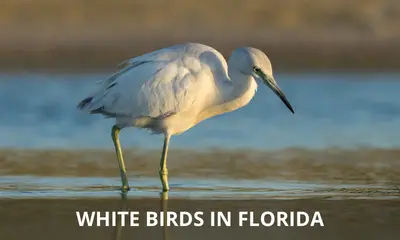
We’ll show you both the birds that are entirely white, as well as the birds that are only partially white, and will also cover where you can expect to find them.
What white birds are found in Florida?
The 17 types of white birds that can be seen in Florida are:
- Great Egret
- Snowy Egret
- Cattle Egret
- Little Blue Heron (Juvenile)
- White Ibis
- Wood Stork
- Whooping Crane
- American White Pelican
- Snow Goose
- Laughing Gull
- Ring-billed Gull
- Forster’s Tern
- Caspian Tern
- White-tailed Kite
- Swallow-tailed Kite
While many of these birds are year round residents of Florida, others only occur in the state during the nesting season in summer.
Yet other birds are winter visitors in Florida, and some are scarce vagrants that are rarely seen in the state (more on that below).
Now let’s dive into the details, and take a closer look at each of these species in order to get the full scoop:
Great Egret
Scientific name: Ardea alba
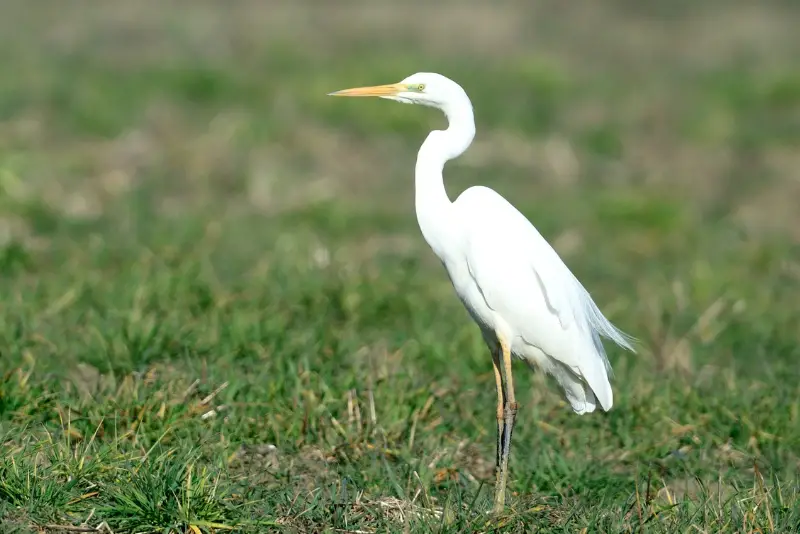
The Great Egret has a range that spans nearly the whole planet, and can be found on almost all continents.
This heron is a big bird that is all white, and it has long black legs and feet along with a thick, yellow beak.
During the spring and summer breeding seasons, the Great Egret grows a plume on its back that extends all the way to the tip of its tail.
It lives in both saltwater and freshwater habitats, and often nests in large colonies on the shores of marshes, lakes, and rivers.
Great Egrets forage in any type of shallow water, including ponds, lakes, rivers, estuaries, as well as rice fields and other flooded areas.
It is especially prevalent in the eastern and central regions of the state throughout the summer.
Outside of the breeding season it is less common, but where it occurs it can be seen in large flocks.
Snowy Egret
Scientific name: Egretta thula
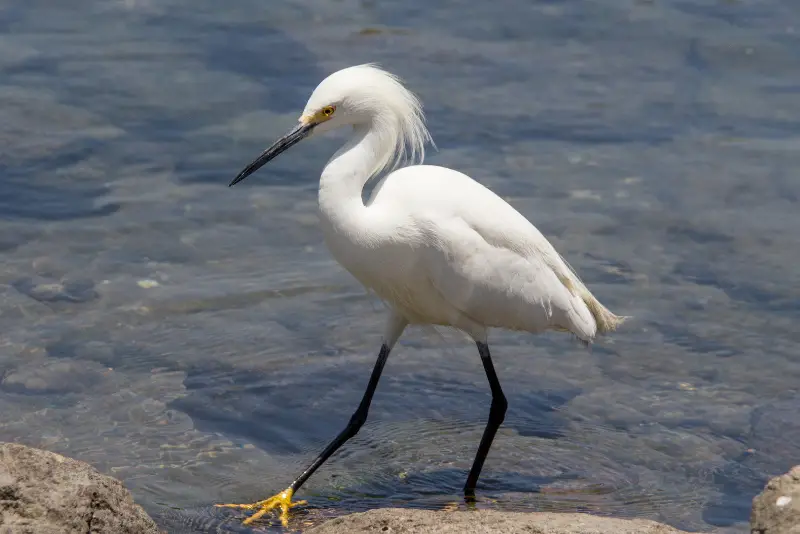
The Snowy Egret has become an increasingly common breeding bird all over Florida.
This is due to aggressive conservation efforts that were necessary because this Egret species was systematically hunted in previous centuries.
This little white heron stands out due to its slim black bill and bright area between the eyes and nostrils.
In adult birds, the feet are a brilliant golden yellow, while the legs are totally black. It is thought that the brightly colored feet help to attract small fish and other prey.
The legs of juvenile birds have a predominant greenish yellow color, with some black areas on the front of the leg.
It is found in practically all types of wetland environments, from small ponds to saltwater and everything in between.
During the summer, the Snowy Egret is a rare to relatively common breeding bird in the state.
It is much more common during the winter months, when large numbers can be observed in the coastal areas of Florida.
Cattle Egret
Scientific name: Bubulcus ibis
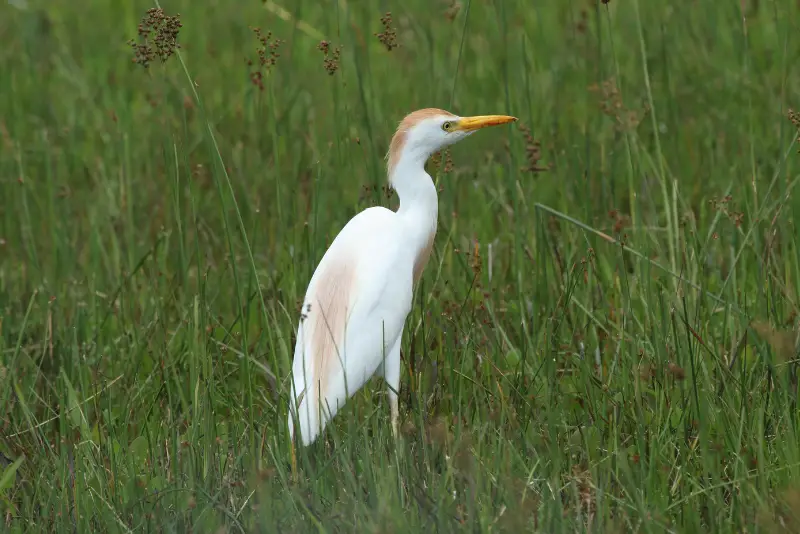
The Cattle Egret is a relatively new species in the New World that originated in Europe and Africa.
Nobody knows how these birds crossed the Atlantic, but they were first discovered breeding in Brazil, and later in Florida, where these birds first appeared in late 1955.
Cattle Egrets have been very successful at colonizing the Americas, and are common breeding birds all over the state.
In contrast to other egrets and herons, Cattle Egrets regularly forage in dry habitats, including high altitude areas.
This is a small egret that is entirely white, except for the breeding season, when adults develop orange plumage on the back of their head, back, and chest.
The legs and the beak are yellow, but at the peak of the breeding season, these birds take on a ruddy hue.
It inhabits a wide range of wetland ecosystems, ranging from shallow saltwater zones to freshwater ponds, swamps, and lakes.
In addition to wetlands, the Cattle Egret also does a significant amount of its foraging in dry areas, such as pastures, where it likes to follow cattle and feed on the insects disturbed by the livestock.
Little Blue Heron (Juvenile)
Scientific name: Egretta caerulea

While adult Little Blue Herons are slate blue, young birds are entirely white during their first year.
Juvenile birds can be distinguished from other white herons by their dark bill and green legs.
These small herons are common breeding birds in Florida that can be seen year-round.
During winter, their numbers swell, due to an influx of birds from further north, which spend the winter months in Florida.
These birds feed on small fish, mollusks and crustaceans, with crayfish forming a large part of their diet.
They prefer an aquatic habitat, where these birds hunt in the shallows, and are rarely seen away from water.
White Ibis
Scientific name: Eudocimus albus
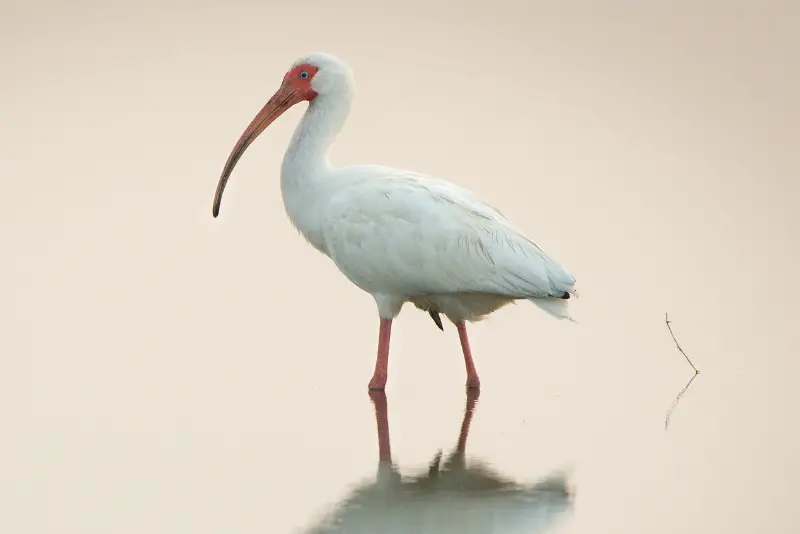
This species is easy to recognize due to its entirely white body and long orange beak that is curved downwards.
The black wing tips are not really apparent until it takes to the wing.
During the first two years of their lives, immature White Ibises have a chocolate brown body with light streaks and a pale orange beak.
While it is most commonly found in coastal areas, such as the Florida Gulf Coast, the White Ibis prefers to forage in freshwater habitats.
This bird feeds on fish, insects, crayfish, and other crustaceans. Crayfish form a large part of its diet in areas where they are common.
They nest in large colonies in forests located close to wetlands. These birds are extremely social, and like to forage in groups of 20 birds or more. In fact, it’s rare to see a solitary White Ibis.
Wood Stork
Scientific name: Mycteria americana
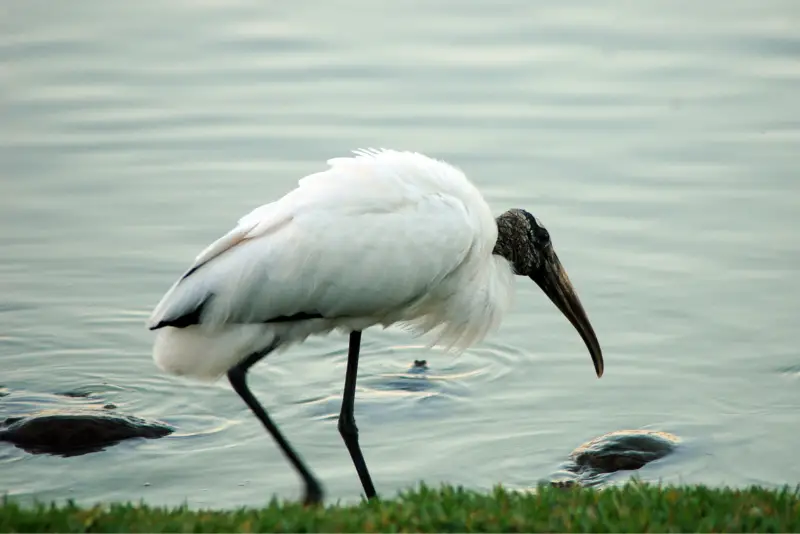
It’s easy to identify a Wood Stork if you can see it up close, due to its entirely white body combined with a bald, black head.
Similar to the White Ibis, the Wood Stork has a bill that curves slightly downwards. However, in contrast to the White Ibis, the Wood Stork has a black bill.
While the tail and wing tips are black, this is usually only apparent when you see a Wood Stork in flight.
The Wood Stork is a large bird, similar in size to a Great Egret, but is easily distinguishable from that species by its curved beak.
Unfortunately, Wood Stork populations have been in decline over the past decades, which is a trend that it shares with many other wading birds.
It feeds on frogs and other amphibians, fish, and aquatic invertebrates. It likes to nest in large colonies in old trees close to foraging areas.
Whooping Crane
Scientific name: Grus americana
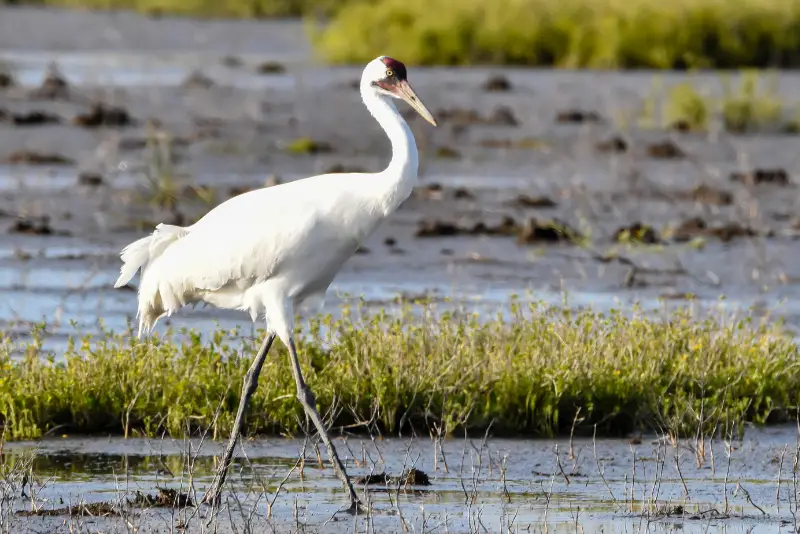
The Whooping Crane was almost at the edge of extinction in the 1930s, with less than 20 birds remaining.
However, sustained conservation efforts have brought it back to a current population that numbers 600 birds.
Adult Whooping Cranes have a completely white body, with a red cap that consists of bare skin. In contrast to adults, juvenile birds have a reddish brown color.
Whooping Cranes are found wintering in Florida during the cold season. These birds breed in Alberta, Canada, and migrate south to spend the winter.
During the non-breeding season, the preferred habitat of Whooping Cranes are marshes, estuaries, and salt flats.
These birds feed mainly on crustaceans and mollusks, with blue crabs making up the largest part of their diet.
While the population of Whooping Cranes has made an amazing comeback from the edge of extinction, it is still a critically endangered species, and in need of continued conservation efforts.
American White Pelican
Scientific name: Pelecanus erythrorhynchos

The American White Pelican is one of the largest aquatic birds in Florida, and is almost entirely white, except for black primary and secondary feathers on its wings.
Its huge beak is bright orange, and has a flat plate protruding from the upper part of the beak during the summer breeding season.
Outside of the breeding season, the bill changes its color from orange to pale yellowish.
American White Pelicans are most often observed in Florida during the winter months, as these birds are winter visitors to the coastal areas of the state.
This aquatic bird feeds almost exclusively on fish, but unlike other pelican species it doesn’t dive in order to catch them. Instead it submerges its head down into the water, and grabs fish with its large beak.
Its preferred habitat are estuaries, shallow bays, and coastal inlets, as well as freshwater lakes further inland.
American White Pelicans are most often seen in groups that like to cooperate with each other when foraging for fish.
Snow Goose
Scientific name: Anser caerulescens
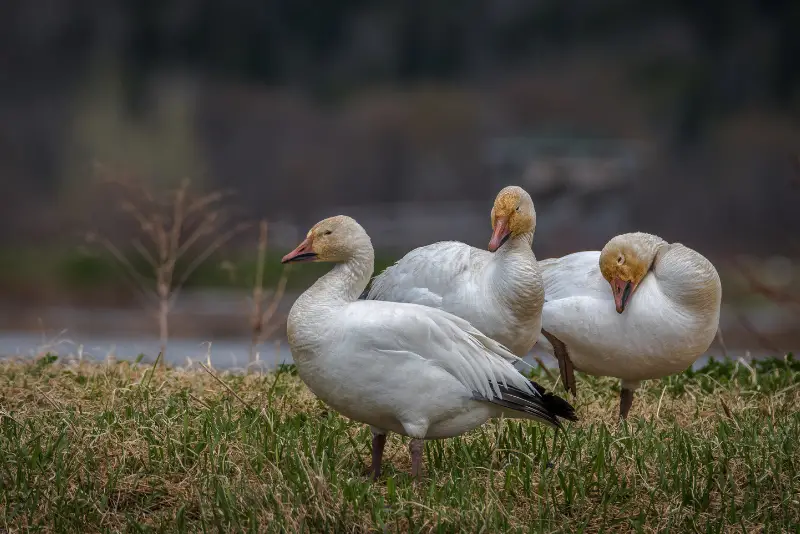
Similar to Trumpeter Swans, Snow Geese are winter visitors in Florida, but the number of wintering Snow Geese has rapidly increased in recent years.
The Snow Goose exists in two color morphs, one of which is entirely white, while the other is blue gray with a light cream head.
The Arctic population of Snow Geese has gone up significantly in the past few decades, and as result it is also much more common in its wintering grounds.
While Snow Geese were formerly rare winter visitors in Florida, these birds are now commonly seen in the winter throughout the state.
Snow Geese like to feed on harvested farmland, such as wheat fields, where these birds feed on leftover grains. In some cases these birds also forage on rice fields.
Wintering Snow Geese can be seen all over Florida, but are most commonly found in the eastern part. These birds arrive in October, and most of them leave by March.
Laughing Gull
Scientific name: Leucophaeus atricilla
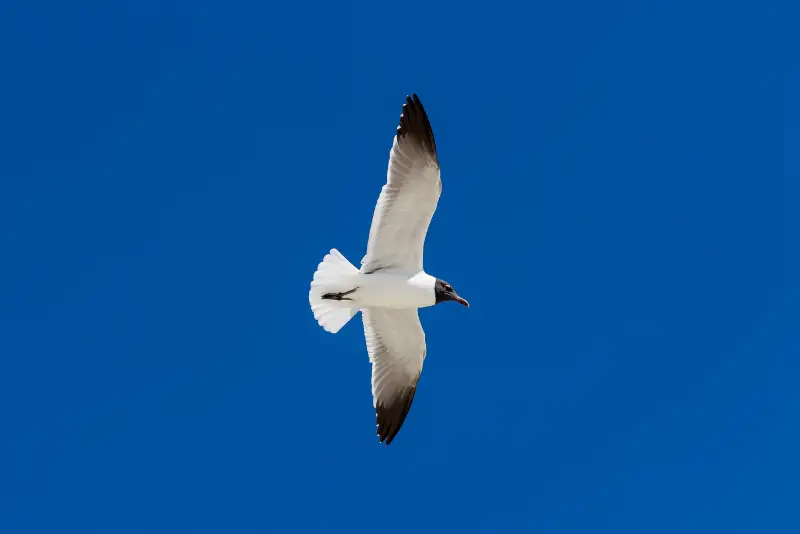
The Laughing Gull is common along the entire coast of Florida, and can be easily identified by its black head and its loud call that resembles human laughter.
Adult Laughing Gulls in summer are largely white, with a black head and gray upperside. Both the bill and the legs are dark red. In contrast to adults, juvenile birds are pale gray brown.
Laughing Gulls are most common close to mud flats and sandy beaches, but these birds also occur away from land, foraging over open water.
These are the most common gulls that live in Florida year-round.
Outside of the breeding season, Laughing Gulls are sometimes also observed further inland on rare occasions, showing up at lakes and reservoirs.
Ring-billed Gull
Scientific name: Larus delawarensis
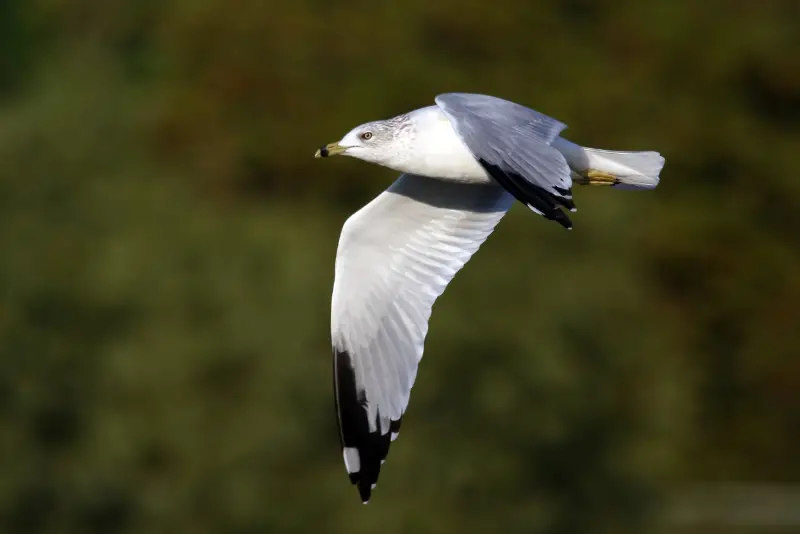
The Ring-billed gull is a common winter visitor throughout Florida. While it doesn’t nest in the state, a few birds can be seen during summer as well.
Adults are almost entirely white, except for their light gray upperparts and black wing tips. The legs and the bill are bright yellow. Juvenile birds are more mottled in appearance, with a mix of brown and gray.
This bird can be confused with the Herring Gull, but the latter is very rare in Florida, while the Ring-billed Gull is common on large lakes and reservoirs.
The preferred habitat of this gull is close to inland bodies of water, although it also forages on parks, landfills, and golf courses. It is the most common gull species seen at large reservoirs.
Ring-billed Gulls are common birds in Florida during the winter, and start arriving in September, and most of them leave by March.
As a scavenger, it likes to frequent garbage dumps, where flocks with hundreds of birds can be seen at times.
Forster’s Tern
Scientific name: Sterna forsteri

The Forster’s Tern is a medium sized tern that is a common breeding bird along the coast of Florida.
Adult birds are almost entirely white, except for their gray mantle and black cap. Their orange beak is black tipped.
In its non-breeding plumage, it loses most of its black cap, but can be identified by a characteristic comma shaped black eye patch.
The main breeding habitat of this tern are shallow coastal waters, including bays, inlets, and tidal flats.
In addition, Forster’s Tern may be encountered breeding in a range of freshwater settings, most frequently at lakes and reservoirs.
Outside of the breeding season, Forster’s Terns are rare winter visitors at reservoirs all over Florida.
Caspian Tern
Scientific name: Hydroprogne caspia
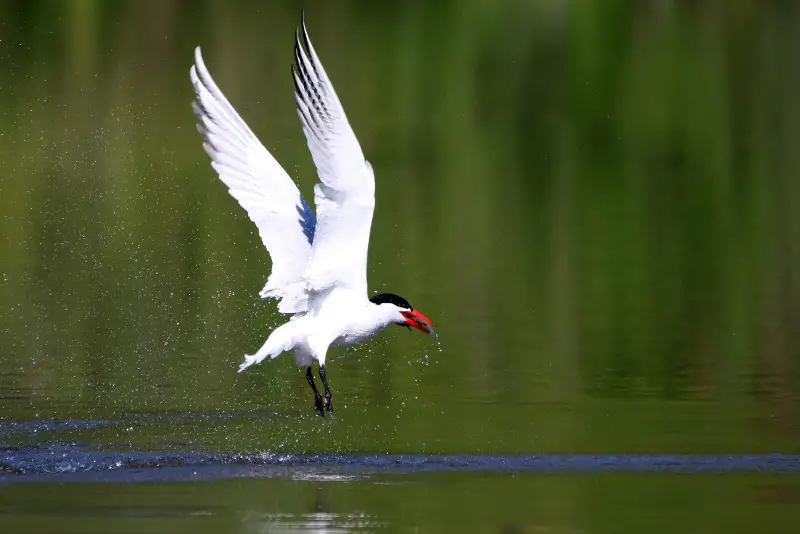
The Caspian tern is the largest tern species in the world, and a rare winter visitor in Florida.
It superficially resembles the Forster’s Tern, but it is a much larger bird and has a thicker bill, broader wings, and a less forked tail.
Also, during winter the Caspian Tern doesn’t lose its black cap completely, but always retains a streaked, dark crown.
Forster’s Terns, on the other hand, lose their cap entirely during winter, which becomes completely white.
The Caspian Tern is not only a skilled hunter, but this bird also steals food from other terns and gulls. It catches fish by diving into the water with astonishing precision.
The Caspian Tern breeds in freshwater habitats in Canada and northern USA, and winters in the Caribbean and the Gulf of Mexico.
White-tailed Kite
Scientific name: Elanus leucurus

The White-tailed Kite is also known as the Black-shouldered Kite, and both of these are apt names for it.
Adult White-tailed Kites have an entirely white underside, head, and tail. Their upper side is light gray, with dark gray patches on the shoulders. The eyes are deep red.
Juvenile birds, on the other hand, have a more brownish color with light streaks.
White-tailed Kites hunt for small rodents, insects and reptiles in open grassland, either from a perch or on the wing.
Similar to kestrels, these birds like to hover in the air over a specific spot, while waiting for a rodent to come out of its burrow.
White-tailed Kites are scarce breeding residents along the coast of Florida, where these birds can be seen year-round.
Swallow-tailed Kite
Scientific name: Elanoides forficatus
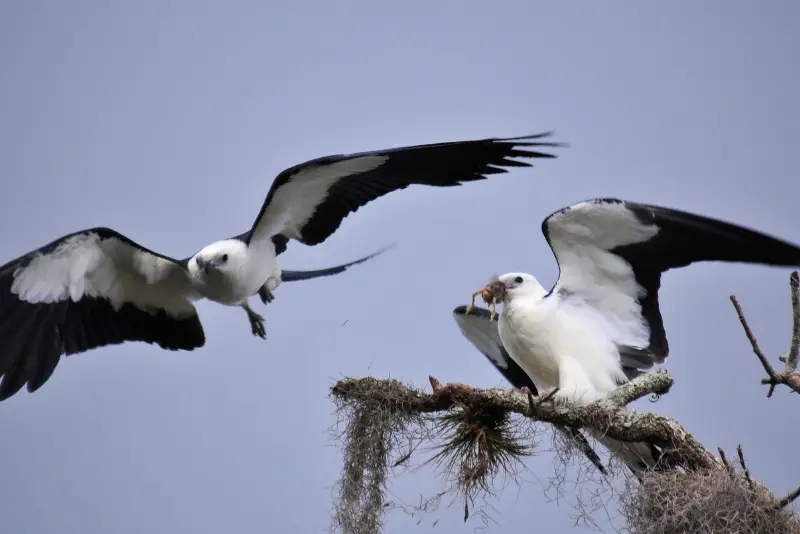
This elegant Florida raptor is easy to identify in flight, due to the combination of its bright white underparts with its deeply forked tail.
The rear margins of the wings and the tail are black. When perched on a tree, its white head and chest contrast with the dark grayish black upperside.
Similar to other kites, this bird is a skilled hunter and capable of catching insects in flight. Its preferred food are small reptiles, rodents, and insects.
The Swallow-tailed Kite is a summer visitor in Florida, and migrates to Central and South America to spend the winter.
Florida has the largest population of breeding Swallow-tailed Kites in North America.
What are white birds in Florida with long beaks?
There are five types of white-colored birds in Florida that have long beaks:
- White Ibis
- Great Egret
- Snowy Egret
- Wood Stork
- American White Pelican
Out of these 5 birds, the White Ibis has the longest beak compared to its body size, and you can also recognize it by the bright orange color of its beak.
If you’re not sure which of these birds you saw, check out the photos in our detailed ID guide above.
Why do white birds hang around cows in Florida?
The white birds that like to accompany grazing cows on their pasture are Cattle Egrets.
Cattle Egrets stay close to cows because grazing cattle flush out insects from the grass, which makes it easier for the egrets to catch them.
What large white birds are found in Florida?
The four types of large white birds you can see in the sunshine state are:
- Great Egret
- Wood Stork
- Whooping Crane
- American White Pelican
If you’re not sure which of these birds you’ve seen, or how to distinguish between them, check out the photos in our detailed ID guide above.
